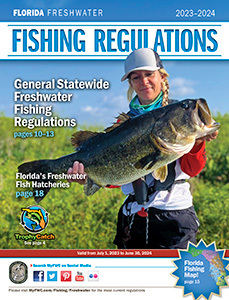Trophy Catch Research Highlights
This year the FWC’s TrophyCatch program is excited to mark the milestone of 10 full years of citizen science data collected from anglers like you since the program’s inception in 2012. To commemorate that achievement, TrophyCatch is celebrating this 11th year as the “Season of Research!” Here is what some of that research has revealed.
Where’s the best place to go bass fishing? Florida, the Bass Fishing Capital of the World, of course! Within Florida, there are more than 8,000 named lakes and 12,000 miles of rivers. Nearly all of them hold bass, with the possibility of a trophy weighing 8 pounds or more that can qualify for submission to TrophyCatch. Based on all TrophyCatch data recorded so far, below are Florida’s Top 5 bass fishing locations.
Where are Florida’s very big bass? These are TrophyCatch Hall of Fame club fish, weighing 13 pounds or heavier. A decade of data pinpointed a definite geographical trend, with central Florida offering a “mega bass corridor” where most of the State’s “teens” or larger have come from (see map below). Clay, Putnam, and Marion counties top the list, accounting for about 40% of all TrophyCatch HOF catches. Plan your fishing trips accordingly!
If you contributed to the data shown here, we thank you for your participation! If you have yet to do so, you can find out more about TrophyCatch on p. 4 and register at
TrophyCatch Top 5 Waterbodies (through March 2023) |
|||||
Waterbody |
Lunker |
Trophy |
HOF |
Total |
% |
Rodman Reservoir |
963 |
200 |
5 |
1168 |
8% |
Lake Kissimmee |
773 |
164 |
2 |
939 |
7% |
Lake Istokpoga |
521 |
97 |
2 |
620 |
4% |
Lake Tohopekaliga |
450 |
80 |
0 |
530 |
4% |
Lake Okeechobee |
422 |
65 |
0 |
487 |
3% |


